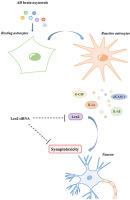Redox Biology ( IF 10.7 ) Pub Date : 2020-12-17 , DOI: 10.1016/j.redox.2020.101837 Erica Staurenghi 1 , Valentina Cerrato 2 , Paola Gamba 1 , Gabriella Testa 1 , Serena Giannelli 1 , Valerio Leoni 3 , Claudio Caccia 4 , Annalisa Buffo 2 , Wendy Noble 5 , Beatriz Gomez Perez-Nievas 5 , Gabriella Leonarduzzi 1

|
Among Alzheimer's disease (AD) brain hallmarks, the presence of reactive astrocytes was demonstrated to correlate with neuronal loss and cognitive deficits. Evidence indeed supports the role of reactive astrocytes as mediators of changes in neurons, including synapses. However, the complexity and the outcomes of astrocyte reactivity are far from being completely elucidated. Another key role in AD pathogenesis is played by alterations in brain cholesterol metabolism. Oxysterols (cholesterol oxidation products) are crucial for brain cholesterol homeostasis, and we previously demonstrated that changes in the brain levels of various oxysterols correlate with AD progression. Moreover, oxysterols have been shown to contribute to various pathological mechanisms involved in AD pathogenesis. In order to deepen the role of oxysterols in AD, we investigated whether they could contribute to astrocyte reactivity, and consequently impact on neuronal health. Results showed that oxysterols present in mild or severe AD brains induce a clear morphological change in mouse primary astrocytes, accompanied by the upregulation of some reactive astrocyte markers, including lipocalin-2 (Lcn2). Moreover, astrocyte conditioned media analysis revealed a significant increase in the release of Lcn2, cytokines, and chemokines in response to oxysterols. A significant reduction of postsynaptic density protein 95 (PSD95) and a concurrent increase in cleaved caspase-3 protein levels have been demonstrated in neurons co-cultured with oxysterol-treated astrocytes, pointing out that mediators released by astrocytes have an impact on neurons. Among these mediators, Lcn2 has been demonstrated to play a major role on synapses, affecting neurite morphology and decreasing dendritic spine density. These data demonstrated that oxysterols present in the AD brain promote astrocyte reactivity, determining the release of several mediators that affect neuronal health and synapses. Lcn2 has been shown to exert a key role in mediating the synaptotoxic effect of oxysterol-treated astrocytes.
中文翻译:

阿尔茨海默病大脑中存在的氧固醇通过激活星形胶质细胞诱导突触毒性:lipocalin-2 的主要作用
在阿尔茨海默病 (AD) 的大脑标志中,反应性星形胶质细胞的存在被证明与神经元损失和认知缺陷相关。证据确实支持反应性星形胶质细胞作为神经元变化介质的作用,包括突触。然而,星形胶质细胞反应的复杂性和结果远未完全阐明。AD发病机制中的另一个关键作用是脑胆固醇代谢的改变。氧甾醇(胆固醇氧化产物)对脑胆固醇稳态至关重要,我们之前证明,脑内各种氧甾醇水平的变化与 AD 进展相关。此外,氧甾醇已被证明有助于参与 AD 发病机制的各种病理机制。为了加深氧甾醇在 AD 中的作用,我们调查了它们是否有助于星形胶质细胞的反应,从而影响神经元健康。结果表明,存在于轻度或重度 AD 大脑中的氧甾醇可诱导小鼠原代星形胶质细胞发生明显的形态变化,同时上调一些反应性星形胶质细胞标志物,包括 lipocalin-2 (Lcn2)。此外,星形胶质细胞条件培养基分析显示,Lcn2、细胞因子和趋化因子的释放显着增加,以响应氧甾醇。在与氧甾醇处理的星形胶质细胞共培养的神经元中,已证实突触后密度蛋白 95 (PSD95) 显着降低,同时裂解的 caspase-3 蛋白水平增加,指出星形胶质细胞释放的介质对神经元有影响。在这些调解人中,Lcn2 已被证明在突触中发挥重要作用,影响神经突形态和降低树突棘密度。这些数据表明,AD 大脑中存在的氧甾醇促进星形胶质细胞的反应性,决定了影响神经元健康和突触的几种介质的释放。Lcn2 已被证明在介导氧甾醇处理的星形胶质细胞的突触毒性作用中发挥关键作用。











































 京公网安备 11010802027423号
京公网安备 11010802027423号